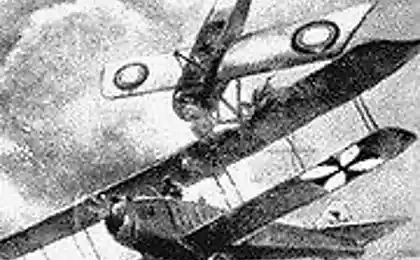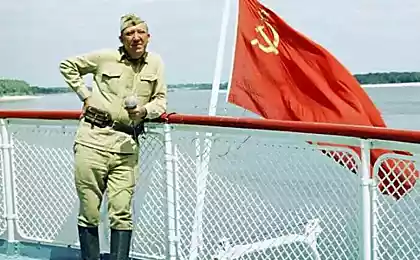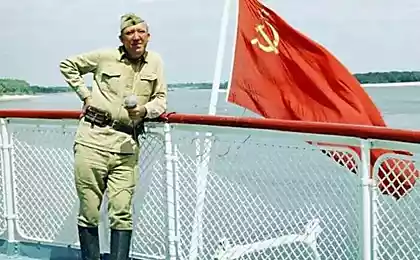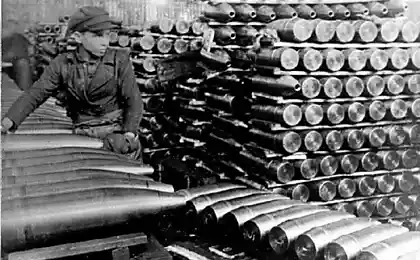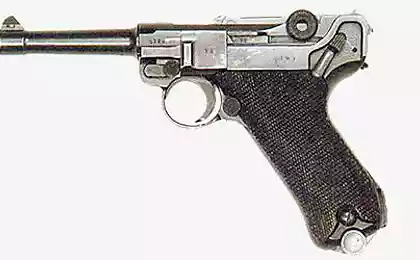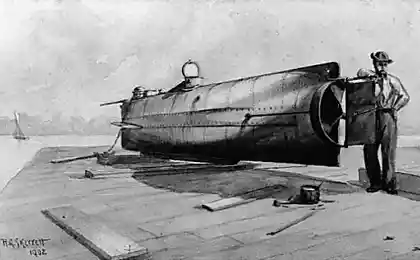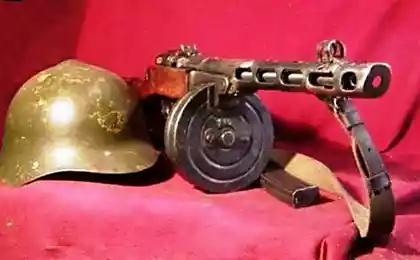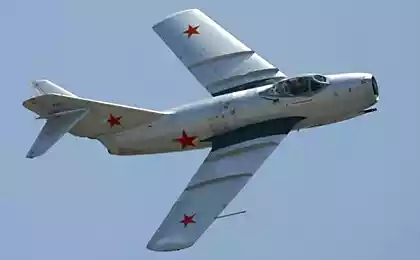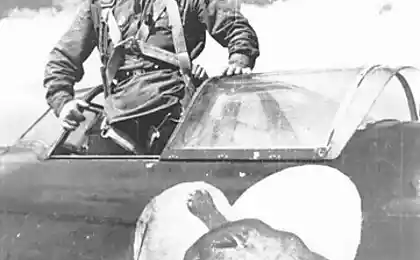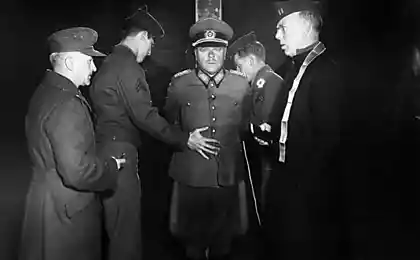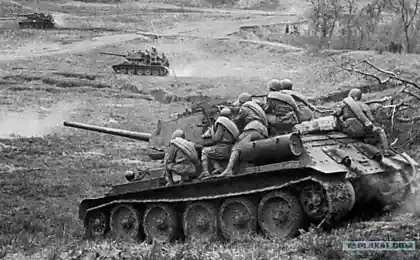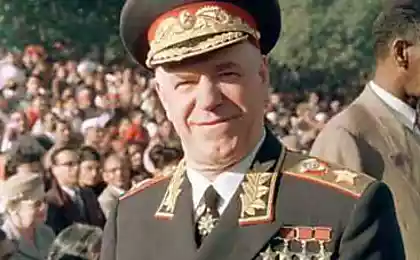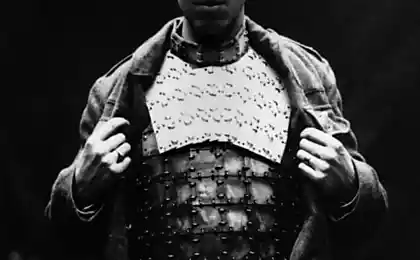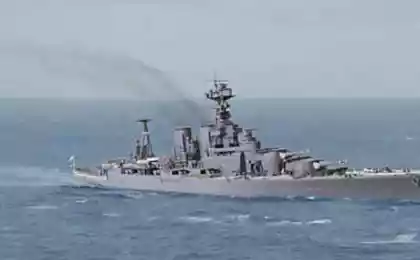1308
The best pilots of the First World War.
So, I represent your eyes its own selection of the best aces of the First World War.
As is well known pilots were all sorts of noble family, and almost did not know each other and were in some schools, and respect for the enemy was at the highest level.
Results will be given 6 countries and 9 letchikov.proshu not break when I finish I will inform you.
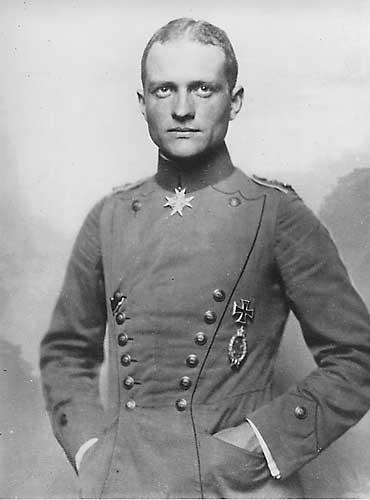
The most outstanding ace of the Russian Empire.
Over the three years of war Cossacks personally shot down 17 and in group battles another 15 enemy aircraft and was recognized as the most effective Russian fighter pilot during the First World War. Some publications indicate that he shot down 32 aircraft in person, but most likely the authors combine personal and group victory Kazakova.
August 1st, 1919 Kazakov was killed in a plane crash.
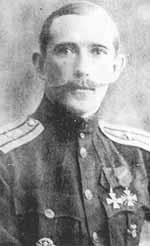
Arge Pavel.
The second impact of the Russian ace.
On his account was 15 enemy aircraft.
October 30, 1922, flying with a load of mail from Prague to Warsaw, died in a plane crash in the Czech Tatra Mountains, near Trutnov (Trantenau), crashing into a thick fog in the rock.
He was buried in Paris.

Italy.
Francesco Barack
Highest Italian ace of the First World War and even perhaps for all the wars in Italy.
On account of his 34 enemy aircraft, he died under unknown circumstances, June 19, 1918.
He also is known for his Prancing stallion which was subsequently received from the mother of Francesco racer Enzo Ferrari.
It is the emblem of this stallion Ferrari.
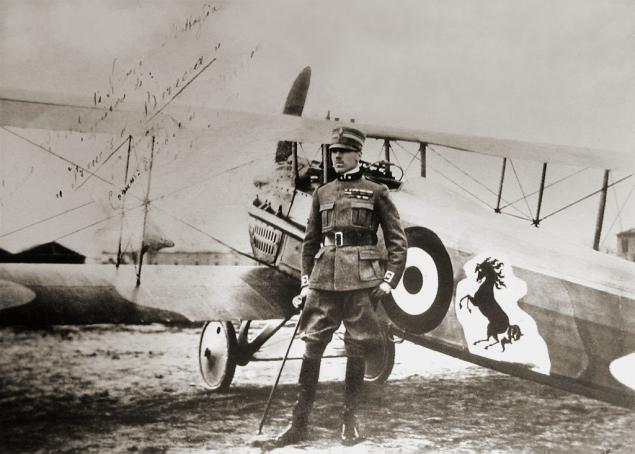
England.
Roy Brown.
And though Roy is not the highest scoring ace of the British World War I, but
it was his, I decided to include in its ranking because of his outstanding victory, because it is considered
responsible for the death of the First World best ace Manfred von Richthofen, April 21, 1918.
April 22, Roy took part in the funeral of the "Red Baron," is how he describes the events:
"In my throat was com. If he was my best friend - my grief would be exactly the same. »
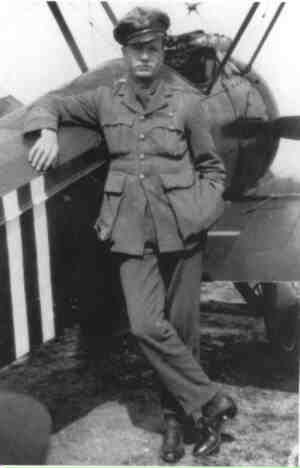
US
Edward Rickenbacker was one of the most successful American fighter pilots of the 1st World War. Total to his credit including 26 shot down enemy planes.
After the war, he became a businessman. During the 2nd World perform special tasks for the US Air Force, including the USSR.
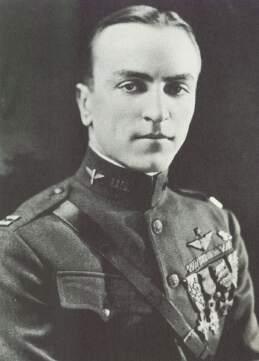
France.
Rene Fonck
French fighter pilot of World War I,
with 75 enemy aircraft shot down an ace is number 1 of the Entente and the second ace of the war (after Manfred von Richthofen).
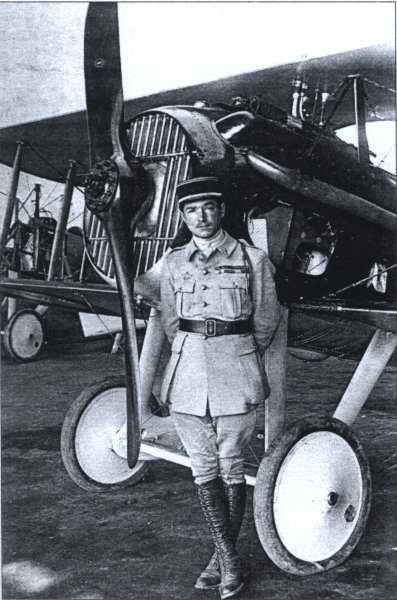
Germany.
Manfred von Richthofen.
Manfred Albrecht Freiherr von Rihtgofen- German fighter pilot, became the best ace of World War I with 80 enemy aircraft shot down. It is widely known by the nickname "The Red Baron", which he received after he got the idea to paint in bright red fuselage of his aircraft Albatros DV, then Fokker Dr.I., and due to its belonging to the German baron Freiherr nobility.
It is still considered by many "ace of aces».
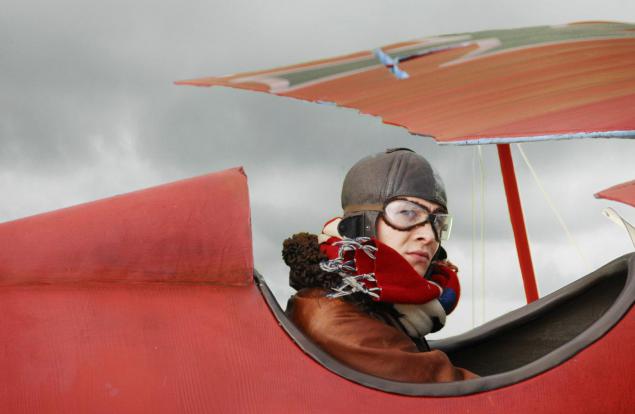
Death
That is what is written on the death of the best ace of the First World:
Referring again to the writing of Richard Wenzl:
- Richthofen always wanted to prove himself all over. He wanted to fly from Freiburg im Breisgau with Volfskhenom (Hans-Joachim Wolf cub nicknamed, Wolffchen) hunting in the Black Forest. Everything was ready - it's up to the weather.
Maybe he changed his mind to fly Richthofen, hoping to catch up in the short term a winning score to hundreds, perhaps - were other reasons. The fateful day of April 21 Richthofen made a few mistakes.
Pilots JG I was tasked to clear the sky over the valley to the east of the Somme Amiens to allow double scouts take pictures Australian artillery position near the bridge Morlankur. These guns were a threat to concentrating in the area before the attack Hamel Amiens troops. Combat mission assumed the offensive pilots "Richthofen's Circus" and not a typical flight to patrol and interception of enemy aircraft over the territory occupied by the Germans.
On the morning of April 21 von Richthofen on his red triplane Dr.l 425/17 he led a group of Fokker and "Albatross».
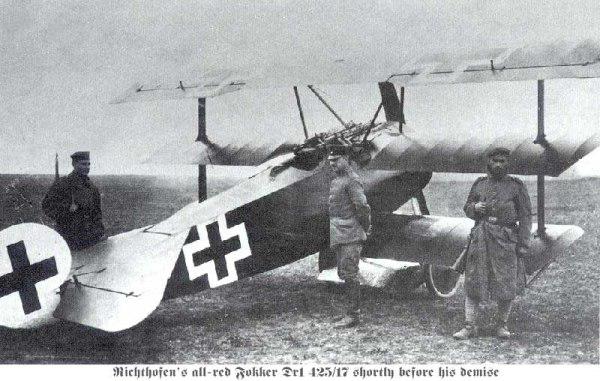
Above the front line the Germans met a couple scouts RE.8 of the 3rd Squadron of the Australian Air Corps. Red-Triplanes attacked enemy planes, but on the plane Baron refused guns. At the same time observer of one of the scouts entertained a good queue Dr.l Lieutenant Hans Weiss, killing him thrust rudder. Weiss came out of the battle.
Richthofen found a broken trigger rods guns. Shoot it was only possible manually, which was necessary to stoop to the dashboard itself. For the convenience of Baron unbuckled seatbelts.
Rebuilt after the attack reconnaissance aircraft collided with the German "Camel" from the 209th British squadron. British fighters led into battle experienced Canadian commander Captain A. Roy Brown. We now know that both sides in the battle attended by newcomers: cousin Wolfram Richthofen nicknamed Dr. Ulf on 1 and Wilfred May (school friend of Brown) in the "Camel».
Mae tried to attack aircraft Wolfram von Richthofen, but machine guns to "Camel" was denied. Mae headed home. It noted rittmeyster, who was eager to win the 81 th victory.
As already mentioned, in that fatal day Richthofen made several mistakes. From the beginning, he did not consider the direction of the wind that blew in the wind that day. Usually over Northern France, the wind blows from west to east, but the late morning of April 21 the wind was blowing from east to west. German fighter pilots believed that blowing from west to east, the wind gives them an advantage. Tailwind "tightened" British deep into territory controlled by the Germans, while the British had to go back to the front line against the wind - the speed of the plane crashes. Richthofen did not consider the wind direction, which was incidental to the Germans. Due east wind Richthofen turned west than expected, over the territory occupied by British troops.
As a rule, the German pilots did not cross the front line, making an exception only for the purposes of the highest priority attacks - some balloons and reconnaissance aircraft.
May fell to the ground, hoping to break away from the triplane, maneuvering among the hills and trees. Von Richthofen persistently followed his counterpart. Due to the constant distraction to the gun Baron soon faced with two problems at once.
The first problem was the left podletevshy "Camel" Roy Brown, the second - the height of the south of the Somme.
Richthofen easily dodged the attack Roy Brown, but with the tail of "Camel" young pilot ace fell. Richthofen began to climb to cross the hill. Along the way, Baron turned up some left "Camel". British fighter survived only thanks to a final rejection of arms on red Dr.l. Richthofen remained only one way - as soon as possible to the east, to the height Morlankurt.
By triplanu was fought fierce fire from the ground. Just as soon as the triplane passed the crest height Richthofen received a perforating wound, the bullet entered the back and exited just below the left nipple - in the area of the heart.
An experienced pilot switched off the engine on the machine, cut off the fuel line, and then began to try to land the plane. In severely injured ace was not strong enough to land all the rules. Triplane at the touch of the earth blew the chassis, in addition to the pilot were injured and another injured. When the plane ran the British gunners, Richthofen was still alive. He died a few minutes later.
Richthofen errors cost him his life. He made a mistake when choosing a place of battle, as did not consider wind direction and speed. In combat, Richthofen broke away from the slaves, which are usually insured commander to attack from behind. The Baron in the day flew too low, hesitated with the decision to return home because of the failure of weapons.
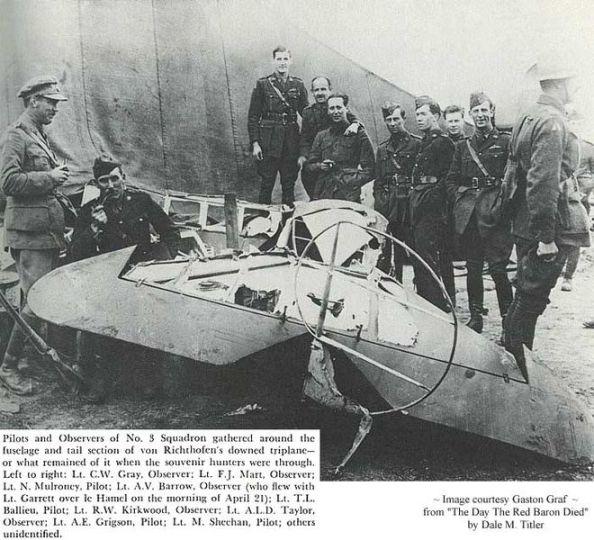
Another outstanding people from Richthofen.
Lothar von Richthofen.
The younger brother of the Red Baron.
As the older brother started the war in the cavalry. He transferred to Luftstreitkräfte in 1915. Entered Jasta-11 March 6, 1917. By the end of the Bloody April had 16 victories. After the death of the Red Baron for a while commander of Jasta-11.
By May 13 Lothar already had 23 victories. May 13 was hit by fire defense. May 14 was awarded the Order Pour le Mérite. Because of the injuries was not involved in the hostilities of 5 months.
The latter won the August 12, 1918 an airplane Fokker DVII. During the war, he was wounded three times. Taking into account the time spent in hospitals, it can be called the most effective ace of the First World War.
After the war he worked in commercial aviation. He died in a plane crash July 4, 1922. The passenger aircraft D1481 Berlin-Hamburg refused engine.
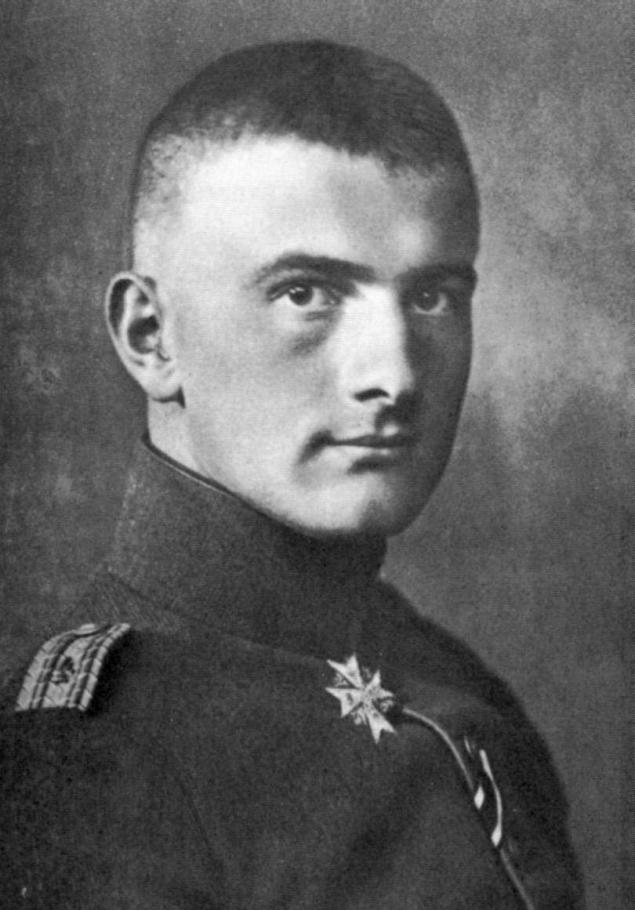
Werner Voss
Born in Krefeld in a Jewish family. "Krefeld hussar." 48 wins.
The war began Westphalia hussar regiment in 1914. transferred to the aircraft. Trained in Igelsberge. It was sent to Jasta 2 Oswald Böhlke. Flown together with Manfred von Rihgtofenom (the Red Baron). Albatros D.III Werner was adorned with a swastika and the heart. For 4 months in Jasta 2 won 25 victories. Red Baron considered him his best friend and main competitor.
March 17, 1917 received the Order Pour le Merite.
In May 1917 after the scandal was transferred to Jasta 5. The Jasta 5 stayed only 1 month. June 28, 1918 transferred to the post of commander in Jasta 29. After 5 days, appointed commander of Jasta 14. At the end of July 1917 Manfred von Rihgtofen appointed him commander of Jasta 10. After this victory by Foss began to grow again.
September 23 Foss won the 48th victory, and was about to leave on vacation. But he decided to make another sortie. One attacked 7 60 British aircraft and 56 squadrons in the composition of which was Major James MakKudden. He was shot down by Lieutenant Arthur Davids (25 victories). I fell under Fresenburg, Belgium.
After the death of his best friend Fossa - Manfred von Richthofen - went to visit a family friend.
Unlike the Red Baron Foss was buried without military honors as an ordinary soldier.
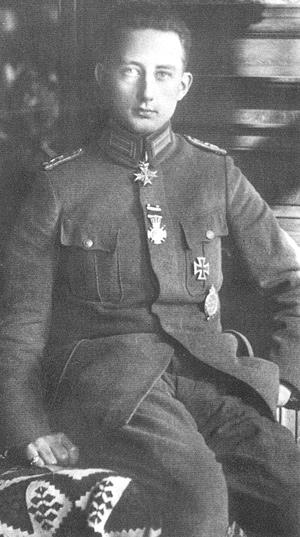
Death.
Eight days after the death of Wolf pilots geshvadera I waited another blow - a combat mission has not returned Werner Voss. On the morning of September 23 Foss scored his 48th victory and going into the campaign with his brother to go to a vacation home in the fatherland.
Foss had to pack your bags. But then he changed his mind. Maybe he decided to use the rest of the day to bring your winning score to an even fifty dollars. Foss told to prepare for the flight FI 103/17. By this time, the engine cover has triplane was painted with white paint smiley design is borrowed from drawings on Japanese kites. Among the history of aviation enthusiasts fierce debate over color color cowl. Passions about this surpasses even the fierce debate on the form of bolt heads on the drive wheels of the tank Pz.Kpfw IV. Yet there is hope in the emergence of talented young scientists who can shed light on these two great mysteries of the history of the XX century. They are waiting for Nobelevka! In regard to color hood airplane FI 103/17 world split into two parts: one vehemently argue that the hood repainted yellow (identification Kohler Jasta 10), others argue if the hood remains in the original olive-brown color.
Later in the afternoon Foss alone patrolled the area adjacent to the front line. There, he ran into a group of SE.5 60th British squadron. Foss was one (though some advanced enthusiasts say that the company was ace in the flight a "Albatross" red), but that does not stop him from attacking. In a short time the Hun brought down the two Englishmen. Voss hoped his victory will confirm ground observers. Meanwhile, on the stage appeared seven SE.5 level in 56 Squadron. Soon they were joined by fighters ring from the same squadron.
56 Squadron was considered one of the best Royal Air Corps. Foss had no idea with whom he would have to fight. Opponents Fossa were the most experienced and effective aces British aircraft, including Dzh.T.B. MakKudden (57 wins in total), F. Rhys-Davies (25 wins), RA Maybury (21 wins), GH Bowman (32 wins), R.T.S. Hoydzh (28 wins), KK Maspratt (8 wins). The most logical move any normal pilot in those conditions - as soon as possible on the lam, the more so because they could not catch up with SE.5 triplane.
Foss was the pilot, to the aggressive recklessness. Rather, Foss intent to fill up one or two opponents, and then have to make sense of feet in the wings. I must say, the grounds for complacency at Voss had. In just a few minutes of the fight falling bullets fired from the guns of the German triplane we got all the planes in the unit, and Cronin and Massprattu even had to withdraw from the battle.
Red "Albatross" (if he existed) in battle did not participate, Foss was alone to deal with six of the best pilots of the Empire. On the legendary battle written much, but better than all of his party MakKuddin wrote in his memoirs «Five Years in the Royal Flying Corps». The history of the battle in the presentation MakKuddena has been translated into many languages and became a series of official historical studies, including the official history of JG I «Jgd in Flanderns Himmel», written Bodenshattsem. MakKudden wrote:
- Now the German triplane was right in the center of our system.
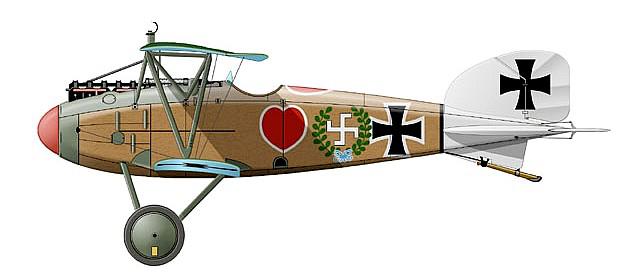
The aircraft maneuvered perfectly. The pilot managed to fire at us all at once. I went by the Germans in the tail, but it managed to hold on to a couple of seconds. The reaction was immediate enemy and unpredictable. None of us could not keep him in sight for shooting enough time ... triplane circled in the middle of the six SE.5. We're all fired. At one point on the track at once triplane agreed with five aircraft.
There is nothing surprising in the fact that the plane was Foss did a decent portion of the lead. The plane began to fall, but then moved to the planning, the engine stopped. Probably Foss blocked fuel stopcock, fear of fire. In planning triplane began to pursue Lieutenant A.P.F. Rhys Davids, he drove the plane Foss decisive turn. Fokker fell north Fresenburg on the British side of the front line. We rushed to the crash site "Tommy" led by Lieutenant Keegan. They pulled out of the airplane charred dead body. Unlike Richthofen Voss buried without military honors as an ordinary soldier, who fell on the battlefield.
After returning to the airfield pilots 56th Squadron long debated what "game" they have filled up, who is the master pilot. Pilots SE.5 not surprised to learn that "in game" was Foss. At the same time on the other side of the front, in JG I, no one really knew how finished his career Werner Voss. The only information the report served as a lieutenant Vendelmana of Jasta 8, in which it was suggested the death in a battle with Voss' Sopwith ».
The loss of two experienced pilots for eight days has undermined the credibility of the Fokker triplanu.
All. Thank you for attention.
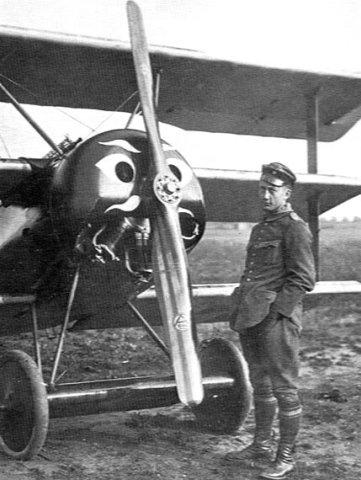
Source:
As is well known pilots were all sorts of noble family, and almost did not know each other and were in some schools, and respect for the enemy was at the highest level.
Results will be given 6 countries and 9 letchikov.proshu not break when I finish I will inform you.

The most outstanding ace of the Russian Empire.
Over the three years of war Cossacks personally shot down 17 and in group battles another 15 enemy aircraft and was recognized as the most effective Russian fighter pilot during the First World War. Some publications indicate that he shot down 32 aircraft in person, but most likely the authors combine personal and group victory Kazakova.
August 1st, 1919 Kazakov was killed in a plane crash.

Arge Pavel.
The second impact of the Russian ace.
On his account was 15 enemy aircraft.
October 30, 1922, flying with a load of mail from Prague to Warsaw, died in a plane crash in the Czech Tatra Mountains, near Trutnov (Trantenau), crashing into a thick fog in the rock.
He was buried in Paris.

Italy.
Francesco Barack
Highest Italian ace of the First World War and even perhaps for all the wars in Italy.
On account of his 34 enemy aircraft, he died under unknown circumstances, June 19, 1918.
He also is known for his Prancing stallion which was subsequently received from the mother of Francesco racer Enzo Ferrari.
It is the emblem of this stallion Ferrari.

England.
Roy Brown.
And though Roy is not the highest scoring ace of the British World War I, but
it was his, I decided to include in its ranking because of his outstanding victory, because it is considered
responsible for the death of the First World best ace Manfred von Richthofen, April 21, 1918.
April 22, Roy took part in the funeral of the "Red Baron," is how he describes the events:
"In my throat was com. If he was my best friend - my grief would be exactly the same. »

US
Edward Rickenbacker was one of the most successful American fighter pilots of the 1st World War. Total to his credit including 26 shot down enemy planes.
After the war, he became a businessman. During the 2nd World perform special tasks for the US Air Force, including the USSR.

France.
Rene Fonck
French fighter pilot of World War I,
with 75 enemy aircraft shot down an ace is number 1 of the Entente and the second ace of the war (after Manfred von Richthofen).

Germany.
Manfred von Richthofen.
Manfred Albrecht Freiherr von Rihtgofen- German fighter pilot, became the best ace of World War I with 80 enemy aircraft shot down. It is widely known by the nickname "The Red Baron", which he received after he got the idea to paint in bright red fuselage of his aircraft Albatros DV, then Fokker Dr.I., and due to its belonging to the German baron Freiherr nobility.
It is still considered by many "ace of aces».

Death
That is what is written on the death of the best ace of the First World:
Referring again to the writing of Richard Wenzl:
- Richthofen always wanted to prove himself all over. He wanted to fly from Freiburg im Breisgau with Volfskhenom (Hans-Joachim Wolf cub nicknamed, Wolffchen) hunting in the Black Forest. Everything was ready - it's up to the weather.
Maybe he changed his mind to fly Richthofen, hoping to catch up in the short term a winning score to hundreds, perhaps - were other reasons. The fateful day of April 21 Richthofen made a few mistakes.
Pilots JG I was tasked to clear the sky over the valley to the east of the Somme Amiens to allow double scouts take pictures Australian artillery position near the bridge Morlankur. These guns were a threat to concentrating in the area before the attack Hamel Amiens troops. Combat mission assumed the offensive pilots "Richthofen's Circus" and not a typical flight to patrol and interception of enemy aircraft over the territory occupied by the Germans.
On the morning of April 21 von Richthofen on his red triplane Dr.l 425/17 he led a group of Fokker and "Albatross».

Above the front line the Germans met a couple scouts RE.8 of the 3rd Squadron of the Australian Air Corps. Red-Triplanes attacked enemy planes, but on the plane Baron refused guns. At the same time observer of one of the scouts entertained a good queue Dr.l Lieutenant Hans Weiss, killing him thrust rudder. Weiss came out of the battle.
Richthofen found a broken trigger rods guns. Shoot it was only possible manually, which was necessary to stoop to the dashboard itself. For the convenience of Baron unbuckled seatbelts.
Rebuilt after the attack reconnaissance aircraft collided with the German "Camel" from the 209th British squadron. British fighters led into battle experienced Canadian commander Captain A. Roy Brown. We now know that both sides in the battle attended by newcomers: cousin Wolfram Richthofen nicknamed Dr. Ulf on 1 and Wilfred May (school friend of Brown) in the "Camel».
Mae tried to attack aircraft Wolfram von Richthofen, but machine guns to "Camel" was denied. Mae headed home. It noted rittmeyster, who was eager to win the 81 th victory.
As already mentioned, in that fatal day Richthofen made several mistakes. From the beginning, he did not consider the direction of the wind that blew in the wind that day. Usually over Northern France, the wind blows from west to east, but the late morning of April 21 the wind was blowing from east to west. German fighter pilots believed that blowing from west to east, the wind gives them an advantage. Tailwind "tightened" British deep into territory controlled by the Germans, while the British had to go back to the front line against the wind - the speed of the plane crashes. Richthofen did not consider the wind direction, which was incidental to the Germans. Due east wind Richthofen turned west than expected, over the territory occupied by British troops.
As a rule, the German pilots did not cross the front line, making an exception only for the purposes of the highest priority attacks - some balloons and reconnaissance aircraft.
May fell to the ground, hoping to break away from the triplane, maneuvering among the hills and trees. Von Richthofen persistently followed his counterpart. Due to the constant distraction to the gun Baron soon faced with two problems at once.
The first problem was the left podletevshy "Camel" Roy Brown, the second - the height of the south of the Somme.
Richthofen easily dodged the attack Roy Brown, but with the tail of "Camel" young pilot ace fell. Richthofen began to climb to cross the hill. Along the way, Baron turned up some left "Camel". British fighter survived only thanks to a final rejection of arms on red Dr.l. Richthofen remained only one way - as soon as possible to the east, to the height Morlankurt.
By triplanu was fought fierce fire from the ground. Just as soon as the triplane passed the crest height Richthofen received a perforating wound, the bullet entered the back and exited just below the left nipple - in the area of the heart.
An experienced pilot switched off the engine on the machine, cut off the fuel line, and then began to try to land the plane. In severely injured ace was not strong enough to land all the rules. Triplane at the touch of the earth blew the chassis, in addition to the pilot were injured and another injured. When the plane ran the British gunners, Richthofen was still alive. He died a few minutes later.
Richthofen errors cost him his life. He made a mistake when choosing a place of battle, as did not consider wind direction and speed. In combat, Richthofen broke away from the slaves, which are usually insured commander to attack from behind. The Baron in the day flew too low, hesitated with the decision to return home because of the failure of weapons.

Another outstanding people from Richthofen.
Lothar von Richthofen.
The younger brother of the Red Baron.
As the older brother started the war in the cavalry. He transferred to Luftstreitkräfte in 1915. Entered Jasta-11 March 6, 1917. By the end of the Bloody April had 16 victories. After the death of the Red Baron for a while commander of Jasta-11.
By May 13 Lothar already had 23 victories. May 13 was hit by fire defense. May 14 was awarded the Order Pour le Mérite. Because of the injuries was not involved in the hostilities of 5 months.
The latter won the August 12, 1918 an airplane Fokker DVII. During the war, he was wounded three times. Taking into account the time spent in hospitals, it can be called the most effective ace of the First World War.
After the war he worked in commercial aviation. He died in a plane crash July 4, 1922. The passenger aircraft D1481 Berlin-Hamburg refused engine.

Werner Voss
Born in Krefeld in a Jewish family. "Krefeld hussar." 48 wins.
The war began Westphalia hussar regiment in 1914. transferred to the aircraft. Trained in Igelsberge. It was sent to Jasta 2 Oswald Böhlke. Flown together with Manfred von Rihgtofenom (the Red Baron). Albatros D.III Werner was adorned with a swastika and the heart. For 4 months in Jasta 2 won 25 victories. Red Baron considered him his best friend and main competitor.
March 17, 1917 received the Order Pour le Merite.
In May 1917 after the scandal was transferred to Jasta 5. The Jasta 5 stayed only 1 month. June 28, 1918 transferred to the post of commander in Jasta 29. After 5 days, appointed commander of Jasta 14. At the end of July 1917 Manfred von Rihgtofen appointed him commander of Jasta 10. After this victory by Foss began to grow again.
September 23 Foss won the 48th victory, and was about to leave on vacation. But he decided to make another sortie. One attacked 7 60 British aircraft and 56 squadrons in the composition of which was Major James MakKudden. He was shot down by Lieutenant Arthur Davids (25 victories). I fell under Fresenburg, Belgium.
After the death of his best friend Fossa - Manfred von Richthofen - went to visit a family friend.
Unlike the Red Baron Foss was buried without military honors as an ordinary soldier.

Death.
Eight days after the death of Wolf pilots geshvadera I waited another blow - a combat mission has not returned Werner Voss. On the morning of September 23 Foss scored his 48th victory and going into the campaign with his brother to go to a vacation home in the fatherland.
Foss had to pack your bags. But then he changed his mind. Maybe he decided to use the rest of the day to bring your winning score to an even fifty dollars. Foss told to prepare for the flight FI 103/17. By this time, the engine cover has triplane was painted with white paint smiley design is borrowed from drawings on Japanese kites. Among the history of aviation enthusiasts fierce debate over color color cowl. Passions about this surpasses even the fierce debate on the form of bolt heads on the drive wheels of the tank Pz.Kpfw IV. Yet there is hope in the emergence of talented young scientists who can shed light on these two great mysteries of the history of the XX century. They are waiting for Nobelevka! In regard to color hood airplane FI 103/17 world split into two parts: one vehemently argue that the hood repainted yellow (identification Kohler Jasta 10), others argue if the hood remains in the original olive-brown color.
Later in the afternoon Foss alone patrolled the area adjacent to the front line. There, he ran into a group of SE.5 60th British squadron. Foss was one (though some advanced enthusiasts say that the company was ace in the flight a "Albatross" red), but that does not stop him from attacking. In a short time the Hun brought down the two Englishmen. Voss hoped his victory will confirm ground observers. Meanwhile, on the stage appeared seven SE.5 level in 56 Squadron. Soon they were joined by fighters ring from the same squadron.
56 Squadron was considered one of the best Royal Air Corps. Foss had no idea with whom he would have to fight. Opponents Fossa were the most experienced and effective aces British aircraft, including Dzh.T.B. MakKudden (57 wins in total), F. Rhys-Davies (25 wins), RA Maybury (21 wins), GH Bowman (32 wins), R.T.S. Hoydzh (28 wins), KK Maspratt (8 wins). The most logical move any normal pilot in those conditions - as soon as possible on the lam, the more so because they could not catch up with SE.5 triplane.
Foss was the pilot, to the aggressive recklessness. Rather, Foss intent to fill up one or two opponents, and then have to make sense of feet in the wings. I must say, the grounds for complacency at Voss had. In just a few minutes of the fight falling bullets fired from the guns of the German triplane we got all the planes in the unit, and Cronin and Massprattu even had to withdraw from the battle.
Red "Albatross" (if he existed) in battle did not participate, Foss was alone to deal with six of the best pilots of the Empire. On the legendary battle written much, but better than all of his party MakKuddin wrote in his memoirs «Five Years in the Royal Flying Corps». The history of the battle in the presentation MakKuddena has been translated into many languages and became a series of official historical studies, including the official history of JG I «Jgd in Flanderns Himmel», written Bodenshattsem. MakKudden wrote:
- Now the German triplane was right in the center of our system.

The aircraft maneuvered perfectly. The pilot managed to fire at us all at once. I went by the Germans in the tail, but it managed to hold on to a couple of seconds. The reaction was immediate enemy and unpredictable. None of us could not keep him in sight for shooting enough time ... triplane circled in the middle of the six SE.5. We're all fired. At one point on the track at once triplane agreed with five aircraft.
There is nothing surprising in the fact that the plane was Foss did a decent portion of the lead. The plane began to fall, but then moved to the planning, the engine stopped. Probably Foss blocked fuel stopcock, fear of fire. In planning triplane began to pursue Lieutenant A.P.F. Rhys Davids, he drove the plane Foss decisive turn. Fokker fell north Fresenburg on the British side of the front line. We rushed to the crash site "Tommy" led by Lieutenant Keegan. They pulled out of the airplane charred dead body. Unlike Richthofen Voss buried without military honors as an ordinary soldier, who fell on the battlefield.
After returning to the airfield pilots 56th Squadron long debated what "game" they have filled up, who is the master pilot. Pilots SE.5 not surprised to learn that "in game" was Foss. At the same time on the other side of the front, in JG I, no one really knew how finished his career Werner Voss. The only information the report served as a lieutenant Vendelmana of Jasta 8, in which it was suggested the death in a battle with Voss' Sopwith ».
The loss of two experienced pilots for eight days has undermined the credibility of the Fokker triplanu.
All. Thank you for attention.

Source:




